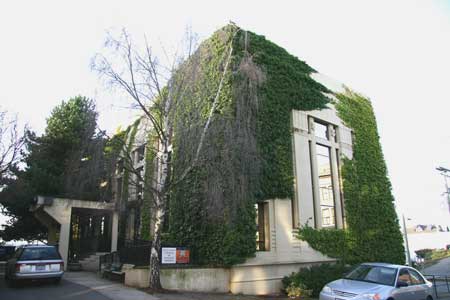ARCHITECTURE:
The Bay Street Sub-Station is a large, flat-roofed, reinforced concrete structure in the Art Deco style with Egyptian Revival motifs. It is located on a prominent sloped corner lot at the intersection of Bay and Government Sts, on the northern outskirts of Victoria’s central core. It is distinguished by a smooth exterior finish, geometric detailing, battered upper walls, cavetto cornices, stylized pilaster capitals, stylized company crests and a banded base. The regular fenestration includes massive, recessed window openings on all four elevations, deeply recessed foundation windows and slit windows. The landscaping includes banked ground planes, unpainted board-formed concrete retaining walls and concrete steps at the NW corner.
Victoria’s earliest and most striking example of Art Deco architecture, it was one of the first Art Deco structures in the province. The Egyptian-inspired detailing is a rarity in BC, recalling the interest generated with the discovery of King Tutankhamun’s tomb in 1922. It is a significant example of the work of Theodor Frederick Körner (1885-1946), who designed this structure while employed by BC Electric’s Construction Dept. Körner was also responsible for other large-scale projects such as BC Electric’s concrete power plant at Ruskin (1930).
ORIGINAL OCCUPANTS:
The Bay Street Sub-Station served a key role in the BC Electric’s infrastructure. Formed in 1897, the company was a driving force in the economy of the city and province through both the provision of power and the operation of transit systems. It remains in business today as BC Hydro, formed in 1961 under Premier W.A.C. Bennett, after his Social Credit govt took over BC Electric and BC Power Commission and nationalized them. This sub-station was the control centre for power distribution for the southern end of Vancouver Island until 1964. It was also the origin of the power lines that serviced the city’s streetcar system, and later, the electric bus system. Its once remote location was due to its industrial function and the significant humming noise that emanated from its machinery.
OTHER OCCUPANTS:
The Sub-Station is an early and rare example of the preservation of Victoria’s industrial heritage. Developer John “Jim” Mace (b. Nottingham, ENG 1922-2019) recognized the potential for adaptive reuse and purchased the vacant building in 1966. Rehabilitation work was carried out in 1974-76, and the cavernous interior was filled with three stories of office space. The exterior was largely preserved, although the grey concrete was covered with cream paint. The renovations were designed by Ojar Kalns Architects of Vancouver. The building has since been occupied by BC government departments and other organizations.

